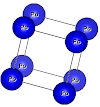As far as I know, two methods are currently used to calculated U in WIEN2k [http://www.cms.tuwien.ac.at/media/uploads/cms/psi-presentations/Blaha.ppt (Slide 10) ]:
1) Fitting method: Adjust U until the desired results are obtained (i.e., until the calculated results are matched to the experimental results)
http://www.mail-archive.com/wien%40zeus.theochem.tuwien.ac.at/msg12261.html http://www.mail-archive.com/wien%40zeus.theochem.tuwien.ac.at/msg12171.htmlThe U value is usually picked for the fit so that it minimizes the average error among several different properties [ J. Chem. Theory Comput. vol. 7 p. 2218 (2011):http://pubs.acs.org/doi/abs/10.1021/ct200202g ].
2) Constrained LDA (cLDA) method http://www.mail-archive.com/wien%40zeus.theochem.tuwien.ac.at/msg11746.html http://www.mail-archive.com/wien%40zeus.theochem.tuwien.ac.at/msg08794.html http://www.mail-archive.com/wien%40zeus.theochem.tuwien.ac.at/msg07587.html http://arxiv.org/abs/1206.3533v2It is noted that Ueff values obtained from this method are known to be of questionable accuracy [ JAP vol. 109 p. 063707 (2011):http://dx.doi.org/10.1063/1.3562145 , PRB vol. 76 p. 155123 (2007):http://link.aps.org/doi/10.1103/PhysRevB.76.155123 ].
There is a comparison between different constrained DFT methods in the file at:
http://www.fhi-berlin.mpg.de/~xinguo/talks/jiang_cdft-coffeetalk.pdfThe linear response method seems to be popular with other DFT software like Quantum-ESPRESSO [ http://hjklol.mit.edu/content/calculating-hubbard-u ].
I hope the references above help and good luck.
Reference: https://www.mail-archive.com/wien@zeus.theochem.tuwien.ac.at/msg12429.html










0 Comments